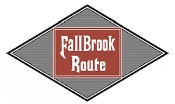
Inspection Car "John" - Photos & News
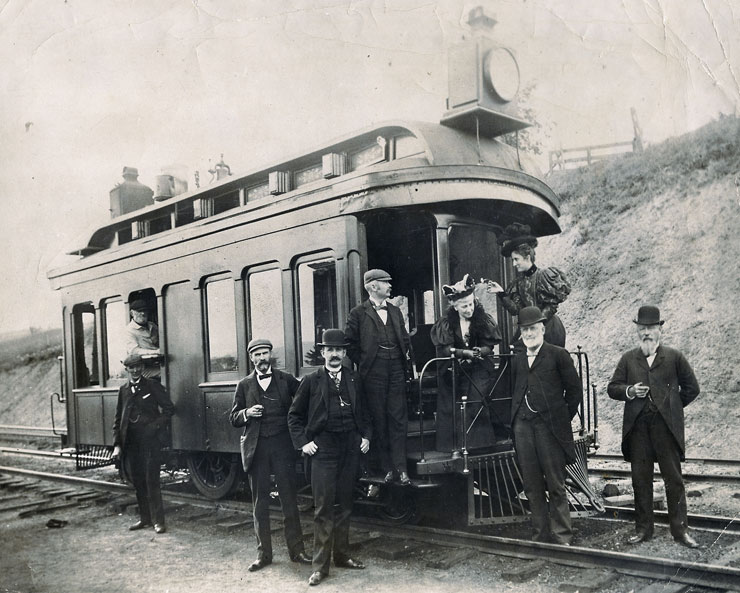
Tentatively identified are: (l-r) Engineer L.B. Manning (in the cab); possibly William Satterly (brakeman); Unknown; Manley T. Inscho, Erie Freight & Passenger agent at Corning; R. H. Caulfield, Civil Engineer, FB Co.; G. R. Brown, General Superintendent, FB Co.; Daniel Beach, VP and General Counsel, FB Co. The two ladies on the platform are Mrs. G. R. Brown and their daughter. Photo: Beach Family Collection
The private inspection car of the Fall Brook Railroads.
Named "John" (occasionally "Little John") in honor of Gen. George J. Magee's son, John Magee. It was used by railroad President Geo. Magee, and later by his son, Col. John Magee, to commute from their home in Watkins, NY to Corning, where the offices were located. In addition to commuting, the car was also used for track inspection, paymaster duties, official tours and occasional family outings. A first, much smaller version of this car was scrapped almost immediately when it was found that it did not have enough power for the grades of the route. It was replaced by an elegantly outfitted 4-2-2, built in the Corning shops by the Fall Brook Coal Company in 1881.
On the exterior it appears like a short passenger car, resting on low trucks, and in color and striping is equal to the finest drawing-room cars. It is propelled by a single pair of forty-two inch driving wheels, which are situated about under the center, having two pistons. It cannot stop at a dead point, Under the passenger compartment is a truck having paper wheels. The other end rests on a single pair of paper wheels, weighing fourteen tons and having excellent spring adjustment. The side motion is less than that of a passenger car at the same speed, and its capability of maintaining the rail is amply guaranteed by its weight and peculiar construction. It is capable of fifty-five miles an hour. The forward compartment is richly furnished and can accommodate ten passengers comfortably. A system of steam pipes radiates the requisite heat in the winter. The upper parts of the doors are plate glass and may be swung open, while the lower part remains shut. This is a particularly enjoyable feature of a summer ride. (Watkins Democrat)
This car was badly damaged in a
fire at the Corning roundhouse in 1883 and was replaced within two months by an even more elegantly appointed car. It was of wood
construction, with an upright, copper boiler, and Victorian furnishings in the passenger section, complete with chandelier. Some of its
construction and furnishing, as well as a number of "incidents" in which it was involved, are reported below. By 1899 it had its
own small brick house in Corning.
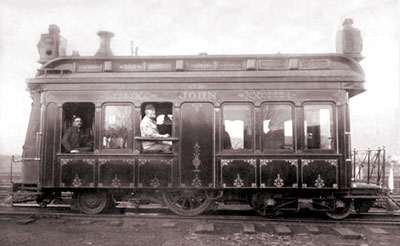
A side-view of the "Little John" showing
ornate decoration and lettered name.
Engineer L. B Manning is at the controls.
We believe
the fireman to be John Krebs.
Beach Family Collection
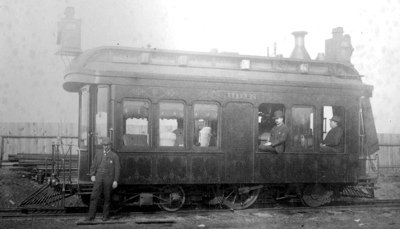
A rare left-side view of "John" at the 1882 annual
meeting at Willard Asylum (NY) where
Gen. George J. Magee was one of the Trustees.
The "John" was the first "passenger" car to travel
to Willard on the
Hayts Corners, Ovid and
Willard Railroad - chartered in 1882. The trip
from Corning
went via the S. G. & C. R. R. to
Geneva, the G. I. & S. R. R. to Hayts Corners,
the H. C. O.
& W. R. R. to Ovid and Willard,
site of the Willard State Hospital.
(Geneva Gazette)
A larger version of this is available
which
shows nice detail.
Collection Edith B. Ford Memorial Library, Ovid, NY
- Thanks to Ron Goldfeder
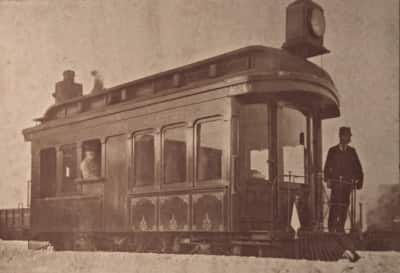
A rare photo of "John" taken by
Hillman Studios in Corning
L.B.Manning, Engineer.
Conductor unidentified. Note white flag denoting
"Special
Train."
Thanks
to David S. Dropkin
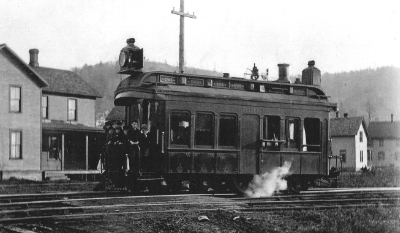
Another left-side view of "John" apparently
giving a platform ride to some schoolboys.
Thanks
to David S. Dropkin
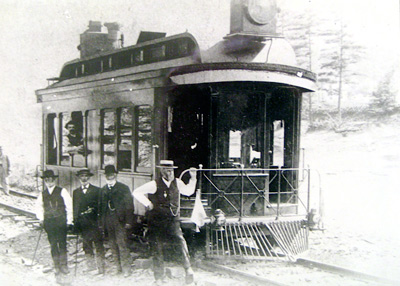
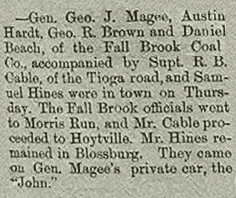
What appears to be a working
inspection
party along the Fall Brook right-of-way.
Note walking sticks.
The
third man from the left appears to be
General Superintendent, G. R. Brown.
Many thanks to Richard Palmer for providing this photo
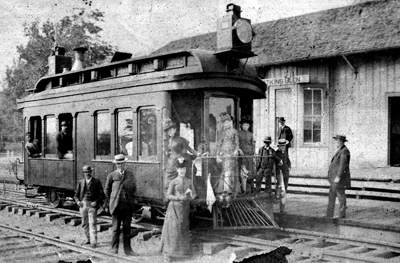
Inspection car "John" at Watkins Glen
station, apparently on the occasion of
a
Beach family outing. Daniel Beach is at right.
Beach Family Collection
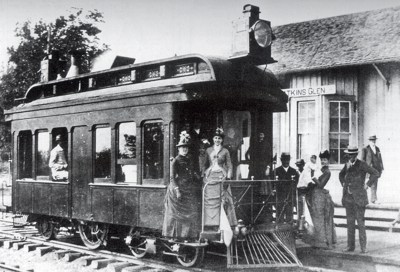
This photo taken on the same
occasion as the photo above, with some
changes in subjects.
From R&LHS Archives
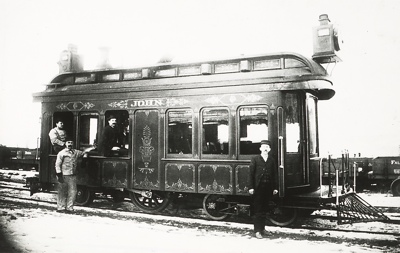
Inspection car "John" at Corning. Because of the
formality of
the pose, there is some speculation
that this may have been the formal portrait
for company records,
showing its 4-person crew.
The meticulous decoration of the car seems
bright and new in this photo.
Sornberger Collection, New York State Library

Another left side
view. Note white flags
denoting extra-class or special train, and the
engineer and fireman at the rear
windows.
Beach Family Collection
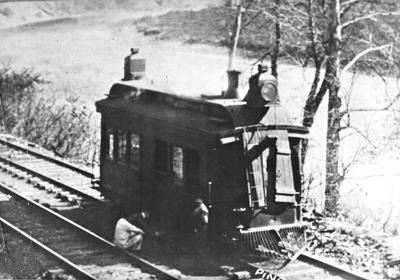
A rare rear view of "John" and crew taking a break.
This appears to have been taken on the Pine
Creek Railway in 1906 after the sale of Fall
Brook to the NYC. It was said that John Magee
kept the car for several years for his personal use.
Beach Family Collection
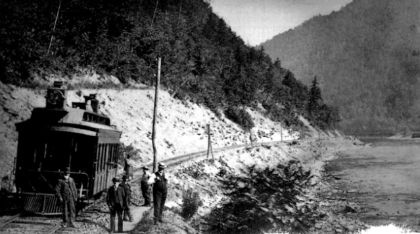
A view of "John" and crew taking a break.
Again, this appears to also have been taken
on the Pine Creek Railway.
This may have been earlier than 1899, however,
as the line is single-track and
Supt. G. R Brown appears at the left.
Beach Family Collection
News Stories Involving the "John"
February 26, 1879 - A new Superintendent's car has made its appearance on the Tioga railroad. It is a nice little coach and engine all combined. (Mansfield Advertiser) [We believe this was the first "John," which was found to be woefully underpowered and was quickly scrapped, and a new one built.]
December 21, 1881 - On Friday at 5 p.m., the writer, by invitation of Supt. Gorton, rode to Watkins Station in the "John", the car of Gen. Magee, President of the S. G. & C. R.R. It went to carry him and Mr. Daniel Beach, and good time was made. It had the "right of way", and freight trains took the switch or waited at stations. It was recently built at the Fall Brook shops, in Corning, and is a fine specimen of iron and wood work. It is a locomotive and coach combined. The engine is first class in strength and finish. The coach part is luxuriously fitted up, and the sides and front are mostly glass, and there are two doors on the front part. There is room for a dozen persons. L.B. Manning, one of the best engineers on any railroad, ran the car. (Corning Journal)
March 22, 1882 - Gen. Geo. J. Magee, President of the Geneva and Corning railroad and of the Fall Brook Coal Company, was in this city Saturday for the purpose of attending the funeral of Charles Chapin. he came in the pony engine "John," which was the object of much admiration at the Central depot during the day. (Rochester Herald as reported in the Watkins Express)
April 13, 1882 - Yesterday afternoon, Watson Cowan was killed by being struck by the engine and coach "John." three or four miles miles south of Corning. He was walking on the track and was deaf ... The "John" had been up to Stokesdale with General Magee and was returning rapidly. His body was hurled against a glass door ..the plate glass fell within upon General Magee and covered the floor. (Corning Journal)
October 24, 1882 - Yesterday afternoon the first passenger train to Manchester carried an excursion party of about forty persons from this borough, including railroad officials and their invited guests ... the excursionists were met by Gen, George J. Magee, Superintendent Gorton, Daniel Beach, George D. Meigs, John Lang and C. B. Hollis, who came up from Corning on the "John" - Gen. Magee's locomotive car ... The "John" led the way and the excursion train followed, over the Marsh Creek division of the new road in Manchester, a distance of eight miles from Stokesdale ... No sane man would have dared to predict ten months ago that the locomotive whistle would awaken the mountain echoes of the Pine Creek gorge in the fall of 1882, but here we saw men busy laying track around the old "narrows," a new depot and freight-house ready for use and new buildings going up in the vicinity in anticipation of business. (Wellsboro Agitator)
December 20, 1882 - Gen. Geo. J. Magee, of Watkins, one of the Trustees of the Willard Asylum reached Willard last Tuesday by his private car "John" via S. G. & C. R. R. to Geneva, the G. I. & S. R. R. to Hayts Corners, the H. C. O. & W. R. R. to Willard, and attended the annual meeting of the board of trustees held at the asylum on that day. The run over the new road from Hayts Corners to Willard we are informed was made in sixteen minutes, a distance of four miles. As the ballasting of the road has not yet been commenced, the time made by his car would show an unusually well made road-bed, and reflects credit upon its makers. (Geneva Courier)
February 22, 1883 - On Tuesday morning the writer left on the combined engine and coach "John" of the Fall Brook Coal Company, on a trip to Blackwells on the Jersey Shore, Pine Creek and Buffalo Railway ... after thirty five mile ride on the road to Antrim, three miles this side of Wellsboro, we reached the junction of the new railroad with the Corning, Cowanesque and Antrim Railroad ...the "John" which was to open to us the mysterious region down the Creek, has for its engineer, Lewis B. Manning, of Corning, one of the most cautious and competent locomotive engineers to be found anywhere. His fireman is John Krebs. When one hundred miles of railroad is built this year from Williamsport to the soft coal mines in Centre and Clearfield counties, much of the coal mined will come over the Jersey Shore, Pine Creek & Buffalo to reach and be distributed by the N.Y. Central. It is a cause for rejoicing that Corning is on the line of such a thoroughfare, and will be head of a Division, and the headquarters of the Fall Brook Coal Company which is to operate the entire route. It is due to William H. Vanderbilt .. to say that it is owing to him that there is to be such a railroad route. It is also due to General George J. Magee to say that he suggested the project to Mr. Vanderbilt. (Corning Journal)
March 29, 1883 - The engine car "John," of the S. G. & C. Railway, passed southward over the Northern Central road on Monday last, en route for Elmira. It contained Superintendent Meade and Chief Engineer Ames, of the N. C. Railway. "John" is no uncommon sight along the line of the S. G. & C., but Monday was the first time it ever passed through Watkins. (Watkins Express)
March 31, 1883 - Gen. Magee's dummy Engine, "John," used for small parties and quick trips over the S. G. & C. Railroad, made a great sensation at Elmira Tuesday afternoon of this week. Superintendent Gorton of the S. G. & C., had been to Himrods Junction to meet Superintendent Meade, of the Northern Central, and having finished their business, Mr. Gorton took Mr. Meade back to Elmira over the N. C. R., returning via the Erie. When the "John" stopped at the Elmira Union Depot, it was surrounded by a thousand people in a moment. (Havana Journal)
April 4, 1883 - The Corning correspondent of the Elmira Advertiser gives the following description: Engine "John," the private conveyance of General George J. Magee over his railways is such an admirable piece of machinery that a short description may prove interesting. On the exterior it appears like a short passenger car, resting on low trucks, and in color and striping is equal to the finest drawing-room cars. It is propelled by a single pair of forty-two inch driving wheels, which are situated about under the center, having two pistons. It cannot stop at a dead point, Under the passenger compartment is a truck having paper wheels. The other end rests on a single pair of paper wheels, weighing fourteen tons and having excellent spring adjustment. The side motion is less than that of a passenger car at the same speed, and its capability of maintaining the rail is amply guaranteed by its weight and peculiar construction. It is capable of fifty-five miles an hour. The forward compartment is richly furnished and can accommodate ten passengers comfortably. A system of steam pipes radiates the requisite heat in the winter. The upper parts of the doors are plate glass and may be swung open, while the lower part remains shut. This is a particularly enjoyable feature of a summer ride. The other compartment contains the machinery, and has ample accommodations for the engineer and fireman. A bell connected with a cord passing through the forward compartment, give the engineer notice to stop, start, etc. Sufficient coal and water space is provided for long runs. A great many conveyances have been designed for the purpose for which this is used; but in none of them, we venture to say, have the necessary conditions been so perfectly observed. Here is a machine uniting the qualities of absolute safety with a high speed, and at the same time costing but the minimum for repairs, fuel, etc. It was built at the company's shops in this place, from designs furnished by A. H. Gorton, general superintendent, assisted by O. C. Patchel, master mechanic. Mr. Gorton may be proud of his success in engine "John." He has been identified with the railways of the Fall Brook coal company almost since their inception and has demonstrated his fitness for the position in everything which he was called to perform. (Watkins Democrat)
April 5, 1883 - At half-past ten o'clock on Tuesday night a fire broke out in the Round House of the Fall Brook Coal Company. It was soon consumed. There were eight locomotives quartered therein, five being of the largest and two of the ordinary size, besides the old and new "John" - a small engine and coach combined ... The locomotives consisted of five Consolidated engines, each having four pair of driving wheels ... three of the five were entirely new and cost ranged from $14,000 to $15,500 ... it is a calamitous fire, and especially at this time as the Pine Creek Railroad will be finished in a few weeks, and will require much motive power, as it will be operated by the Fall Brook Coal Company. (Corning Journal)
April 10, 1883 - Last Tuesday night the Fall Brook Coal Company's round-house at Corning, N.H., was totally destroyed by fire. The building contained nine locomotives, including the locomotive-car "John," five of which were the new freight engines recently purchased for use on the Pine Creek Railway. The engines were damaged to such an extent that all will have to be rebuilt. The loss is estimated at about $150,000 upon which there was an insurance of $47,000. The fire is thought to have been occasioned by the explosion of oil in a head-light. There are two watchmen employed about the Company's buildings in that part of the village. (Wellsboro Agitator)
June 14, 1883 - It is understood about town that ex-President Vanderbilt, of the New York Central, who has but recently returned from Europe, is soon to pass through here in a special car on a tour of the inspection of the new Pine Creek road. ... At this point, he will doubtless be joined by a party of railway officials, who will accompany him in Gen. Magee's new "John," which is now being finished at the Magee shops in this village. It takes the place of the one, burned here two months ago, and is said to be fitted up with even more elegance. (Corning Journal)
June 21, 1883 - A man was killed near Jersey Shore on the Pine Creek Railroad by the engine "John" yesterday. He was deaf, and did not hear the engine approach. (Corning Journal)
June 21, 1883 - The Corning journal says that General Magee's new "John," which is now nearly finished at the Magee shops in that village, is being fitted up with even more elegance than the one burned two months ago. (Watkins Express)
September 12, 1883 - Wm. H. Vanderbilt, the railroad king of America, with railroad officials and invited guests, of the New York Central Railroad, passed through Geneva yesterday afternoon on the way to Philadelphia, via S. G. & C. R. R. ... the freight and coal trains were all ordered to clear the main track as soon as possible ... when the whistle of Vanderbilt's train was heard the main track was entirely cleared and all the switches examined and put in proper shape ...She was drawn by engine No. 110, the fastest locomotive on the New York Central and managed by the famous engineer, Mr. Wood, who has made the quickest time ever made over the road . ... There were two coaches, the forward one was the cooking and dining room coach, in which were seen the cooks and waiters ... behind this was the "sitting room" coach, handsomely fitted up and finely decorated. In this car were Wm. H. Vanderbilt, J. H. Rutter, president of the New York Central Railroad, and officials of the road and their invited guests, all of whom seemed to be in excellent spirits. ... The General Supt. of the Syracuse, Geneva and Corning Railroad, Mr. Gorton, ordered the "Pony John" engine backed up to the rear end of the Vanderbilt coach, the steps of which were lengthened out and joined to the front of the "Pony John," making a sort of bridge so that the party would not be obliged to step down on the ground. A number of the Vanderbilt party were transferred from the coach and seated into the "Pony Palace," ... the No. 110 engine was detached from the coaches and the Fall Brook coach, the Magee car, drawn by engine number 19, one of the finest passenger engines on the road, and used for special occasions, was backed up and connected to the Vanderbilt coaches. In this coach was General Magee, the president of the Corning road and other officials. This coach was handsomely equipped and elegantly decorated and furnished. ... After a short conversation among themselves the train, with its heavy weights, moved off, headed by the famous "Pony John" engine. (Geneva Courier)
September 18, 1883 - Messrs. W.H. Vanderbilt, W. K. Vanderbilt, Chauncey M. Depew, Hon. Simon Cameron, Frank B. Gowen, Gen. George J. Magee and other prominent railroad men went over the Pine Creek railway on a tour of inspection. The train consisted of an open observation car and two passenger coaches with locomotive in the rear, so that the vision of the railway magnates might not be obstructed. This train was preceded by an engine to insure the clearing of the track, and the locomotive "John" ran some distance in advance of the pilot engine. The party afterwards passed over the Reading road to Philadelphia. (Wellsboro Agitator)
October 18, 1883 - The Corning Democrat of last issue gave the following particulars of a narrow escape from a "smash up," which the engine car "John," with its occupants, Mr. and Mrs. John H. Lang, Mr. and Mrs. Hiram Pritchard, and F. W Janess, had on the Pine Creek road ... Messrs. Lang and Janess go over the route to pay off the employees each month, and on Monday last were on that trip. At Larry's Creek they were overtaken by a freight train, drawn by one of the big "Moguls" that rounded a curve and was upon them before they had time to move out of the way. The engineer threw open the throttle starting the "John," and then he and the fireman jumped, leaving the car without control. The "Mogul" struck the "John" with force enough to break the pilot and steam brake, but the "John" with a full head of steam soon left the scene. Mr. Lang immediately jumped into the cab and took charge of the engine, bringing it to a standstill, without injury to the occupants. (Watkins Express)
August 8, 1884 - Gen. D. S. (sic) Magee's pony engine, the wonder of the youthful mind, was in Geneva last Monday. (Geneva Gazette)
June 11, 1885 - The first train over the Penn Yan and New York road, arrived in Penn Yan last Wednesday afternoon. Gen. Magee's private car, "John," containing himself, and John Lang, A.H. Gorton, H.A. Horning, Wm. Hamlin, Anton Hardt, Daniel Beach and several other gentlemen, carried the party to Penn Yan. (Corning Journal)
June 19, 1885 - Gen. Magee's pony engine passed through Geneva last evening having on board General Magee and a party of friends who were returning from New York where they had been in attendance at the funeral of President Rutter of the New York Central Railroad. (Geneva Gazette)
July 2, 1885 - Through the invitation of Gen. Magee, a party of twenty-one, fourteen of whom were from this village, made an excursion last week over the Pine Creek and Beech Creek roads. A parlor car and dining car were placed at their service and accompanied by the engine-car "John," they left Watkins early Tuesday morning, returning via Williamsport and arriving Wednesday evening. (Watkins Express)
October 16, 1885 - On Monday we enjoyed the pleasure of a ride to Lyons and return in Gen. Geo. J. Magee's combined pony engine and coach, the "John," in company with Gen. Magee and Mr. Gorton, President and Superintendent respectively of the Syracuse, Geneva and Corning Railroad, and of the Fall Brook Coal Company. The car is so arranged that a view is obtained of the road in front as well as of the country through which it passes, and we were most favorably impressed with the fine condition of the Geneva and Lyons branch ... it is said that this branch is one of the best graded and best kept pieces of road in the country... (Geneva Gazette)
May 18, 1886 - Last Friday a special train and locomotive-car "John" carried a party of railroad officials over the Pine Creek and Corning, Cowanesque and Antrim Railways. (Wellsboro Agitator)
August 13, 1886 - Gen. Geo. J. Magee, Austin Hardt, Geo. R. Brown and Daniel Beach, of the Fall Brook Coal Co., accompanied by Supt. R. B. Cable of the Tioga road, and Samuel Hines were in town ...They came on Gen. Magee's private car, the "John." (Blossburg Advertiser)
November 25, 1886 - Governor Hill arrived in Havana on Saturday and spoke the the impressive exercises in memory of Charles Cook, deceased. While in Havana, he was the guest of Hull Fanton, Esq. He was the guest of General Magee at Watkins Saturday night and on Sunday forenoon he came to Corning in company with General Austin Lathrop on General Magee's private car "John." (Corning Journal)
October 14, 1887 - Gen. Magee run down to Geneva last Wednesday on his pony engine "John." ... To-day the General starts with the same power and a combination palace and dining room car attached on a trip 200 miles south. That's the way to travel for solid comfort. (Geneva Gazette)
November 10, 1887 - On a recent occasion a party of Rochesterians - Messrs. George Darling, C. S. Tappan, S. B. Stuart and another - by invitation of President Magee took a trip over the entire system operated by the Fall Brook company. They were met in Geneva by Gen. Magee in his attractive pony engine the "John," and accompanied by Superintendent Canfield and Traffic Manager Kershner were conveyed to Dresden and thence by the new branch to Penn Yan. Here the genial Capt. Tuthill met and dined them sumptuously at his handsome residence. (Rochester Union reprinted by the Watkins Express)
October 3, 1889 - General Magee of the Fall Brook, arrived in this city yesterday afternoon about 2 o'clock via the Erie in his private car "John." He was on his way to Gillette, on the Northern Central, to attend the golden wedding of some relatives in that place ... (Elmira Advertiser)
November 27, 1890 - Last Friday night while approaching the station of Peale on the Beech Creek Railway, Gen. Magee's combination coach and engine, the "John," jumped the track and crashed into a freight car standing on a siding. Flagman Charles Clark, of Corning, and a Beech Creek conductor were in the front end of the John and though that part of the car received the brunt of the damage, they were not seriously hurt. The engineer of the John was L.B. Manning, of Corning. He was running the coach at a good rate of speed and did not have time to reverse the engine. Just beyond the freight car into which the John plunged was an embankment 300 feet high, and but for the obstruction, the John and its crew would have been whirled to destruction. (Corning Journal)
December 4, 1890 - Gen. George Magee, of Watkins, President of the Fall Brook Railroad; H. J. Haden, second vice-president of the New York Central; Mr. Lang, General manager of the West Shore Railroad, and Hon. Daniel Beach, of Watkins, visited Penn Yan on Wednesday last on an inspection tour. They came over the Fall Brook road in the special car "The John" (Penn Yan Express)
June 11, 1891 - As guests of Superintendent Geo. R. Brown of the Fall Brook Railroad in Gen. Magee's engine "John" yesterday were C. A. Hungerford, Robert E. Clisdell, and F. C. Brown, who went on a trip over the Pine Creek division to witness the paying off of the many employees on this division, which is noted for grandeur and picturesqueness the entire length. (Elmira Daily Gazette and Free Press)
July 15, 1891 - It (John) is General Geo. J. Magee's private engine, with a handsomely fitted up compartment adjoining. This part is all fitted up in the latest style and is a "beauty" throughout ... the chairs in "the annex" are all finely upholstered while beautiful damask curtains hang at the windows. The brass and bronze fittings are elegant. A picture of John Magee, son of the General, [for whom the car is named] adorns the interior. (Elmira Daily Gazette and Free Press)
September 26, 1891 - This morning, John Krebs, who is the engineer on Gen. Magee's private engine "John," took a party of fifteen to Keuka Lake and Penn Yan for a day's pleasure. (Elmira Daily Gazette and Free Press)
November 5, 1891 - General Magee's private pony engine and car, the "John," met with an accident on the Pine Creek railroad last Monday afternoon which might easily have proved fatal to the several inmates of the little coach. The "John" left Williamsport just ahead of the passenger train, and was running at a fair rate of speed. When near Safe Harbor a cow deliberately walked upon the track. Before the engineer could stop, the cow had been struck, the engine partially lifted from the track and its pilot driven into the bank beside the track. The "John" was soon hauled back on the rails and though badly strained was able to continue its trip northward. (Wellsboro Gazette)
November 12, 1891 - Monday afternoon in the town of Corning, three miles north of the city, General Magee's private locomotive-car, the "John," was run into by a coal train coming south. The "John" was in charge of Engineer L.B. Manning, and was carrying to Watkins John Lang, Treasurer of the Fall Brook Coal Company, and Daniel Beach, Treasurer of the Morris Run Coal Company. Gen. Magee was not aboard. The oncoming train was seen in time to allow the "John" to slow up, and all hands jumped and escaped injury. The "John" was badly damaged by the coal train. (Corning Journal)
November 12, 1891 - The private engine-car "John," was on the route between Corning and this village, coming northward, and had orders to wait at a station until a train due came in. L. B. Manning, the engineer of the "John," did not notice that the train carried signals for an extra just behind it, and started out. Mr.Beach and Mr. Lang being passengers. The car part of the engine went ahead, and was pushed, instead of drawn, and the engineer soon saw a freight train approaching at full speed, and so near that he could not reverse his engine soon enough to avoid a collision. But he instantly reversed the lever, warned the two officials to spring for their lives, and they had just time to escape from the "John," when it was fearfully wrecked by the heavy freight train. (Watkins Express)
November 21, 1891 - The very narrow escape of our two highly esteemed fellow citizens, Hon. Daniel Beach and John Lang one day last week, by the wrecking of the Engine-Car "John," in collision with a freight train, while on their way to Watkins from Corning created a great sensation in our village. These gentlemen can be illy spared by this community, and we want them both to remain with us as long as possible. (Havana NY Journal)
May 13, 1893 - A son was born yesterday to Mr. & Mrs. John Krebs. Mr. Krebs is fireman on President George J. Magee's private engine "John." (Elmira Daily Gazette and Free Press)
May 9, 1894 - A party of railroad men enjoyed a ride over the Pine Creek railway from Corning to Jersey Shore a few days ago in the locomotive car "John" The tracks were in splendid condition, and Engineer Manning gave the gentlemen some specimens of speed at the rate of 50 miles per hour. (Corning Journal)
November 18, 1896 - A number of officials of the Fall Brook Railway Company came here on the car John last Thursday, to attend the funeral of the late Henry Sherwood (Wellsboro Agitator)
January 21, 1898 - A serious accident and what may prove to be a fatal accident occurred last evening at what is known as Beer's crossing near Beaver Dams ... both men were more or less intoxicated. As they neared the crossing they mentioned they thought they heard the whistle of the "John," a private car on the Fall Brook railroad .. one of the men who heard the whistle cautioned the other not to drive any further, but the latter would not listen to his warning and drove on the track. Just as the wagon reached the track, the "John" struck it, and the wagon was smashed into kindling wood. The two men were thrown out and badly injured, it being feared that one of them can not live. (Elmira Daily Gazette and Free Press)
June 2, 1898 - Fred Costley, twenty-three years of age, while walking on the Fall Brook Railroad near Knoxville, the other day, was struck by "Engine John" and instantly killed. Young Costley was very deaf and did not hear the approach of Superintendent Brown's special, as the little locomotive is light running and makes but little noise. (Watkins Express)
April 5, 1899 - Last Monday the car "John" carried a party of New York Central and Fall Brook railway officials to this place and over the Pine Creek road, to take an inventory of the stations, section-houses and other property which is soon to change ownership. (Wellsboro Agitator)
June 26, 1899 - The pony engine "John," of the Pennsylvania division Central-Hudson railroad (sic), with a party of prominent track officials, passed through the city this morning. (Geneva Daily Times)
December 16, 1903 - Lewis B. Manning, a long time locomotive engineer, died at 7:30 P.M. on Saturday ... his health had been failing for some time, but he kept at work until last Monday, running the engine to Lyons, where on account of illness, he was compelled to leave it and to return home on a passenger train the next day. ... He entered the employ of the Fall Brook Railroad Company upward of thirty years ago, working for the company until it was absorbed by the New York Central R. R. Company, and continued with the latter Company. As Locomotive Engineer he was accounted very skillful and safe. For a series of years he was engineer of Gen. George J. Magee's private engine and car, the "John," and had the entire confidence of the officers of the Fall Brook Railroad. (Corning Journal)
May 17, 1911 - "The John," a pony engine for many years used by General George J. Magee as his private car, and also by George R. Brown, and other Fall Brook and New York Central railroad officials stands on a "dead switch" in the eastern section of the city, dismantled and ready for the scrap heap. "The John"was a speedy sprinter in its day and will be kindly remembered by many railroaders and others. (Elmira Star-Gazette)
February 28, 1912 - The old private car and engine, "John," formerly used by officials of the Fall Brook Railway, which was a familiar sight along the Pennsylvania division of the Central for many years, has been bought of the Magee family by Martin F. Hanley, of Corning, for $25. The body of the car will be converted into a lunch wagon. (Wellsboro Agitator)
May 24, 1928 -
“Little John” Historic for its Early Railroad Days,
to Become “Hot Dog” Stand -
“The Little John,” the first official car ever used to any extent by officers of the Fall Brook Railroad, the father of the Pennsylvania
Division of the New York Central, for tours of inspection nearly 50 years ago, is no longer in a position where it draws admiration wherever it
goes. For soon the car that once bore some of the most prominent officials and guests of railroad officials in this part of the country, will
bear letters telling the world that within, “hot dogs, ice cream and pop may be secured.”
The once famous car, if it could talk, would
probably be able to tell tales of the early history and romance connected with the Fall Brook Railroad, whose officials carried proudly about
state for 20 years.
The car recently named into the possession of Percy A. Payne, of Painted Post, who purchased it from Emil Stasch. It
had previously been used for many years as a lunch wagon on Erie avenue near Pine street. Mr. Payne has removed it to a place along the Addison
Road near Gang Mills where it is soon to become a wayside stand for dispensing food for man and fuel his steed, the railroad’s greatest
competitor - the automobile.
As hundreds of Pennsylvania Railroad employees, old time officials who have been promoted to high positions
in the service, and pensioners returning to Corning for the annual Fall Brook Association banquet, vivid memories were recalled to many by the
mention of the “Little John.”
John W. Lynahan, who according to some of the oldest officials, knows most of the early history of the
“Little John,” was interviewed by an Evening Leader reporter. Mr. Lynahan, one of the road’s early telegraph operators, long since pensioned from
service and one of the most popular and oldest of the New York Central employees, gave the reporter a splendid account of the life story of the
“Little John.”
The historic “Little John,” as Mr. Lynahan recalls, came into existence in the early ‘80s but even before it had made
its appearance upon the horizon, it had been preceded by a little brother, a tiny steam driven car that was used by officials in making
inspections of the road. According to Mr. Lynahan this first car, which was the official car of A. H. Gorton, superintendent of the Fall Brook
Railway and father of Dr. W. E. Gorton, was nothing more than a “glorified hand-car” with barely room enough in front of the engineer for three
persons.
It served its purpose for a time, however, but there was general thanksgiving among officials who traveled the road when this
vehicle that nowadays would seem a tiny toy, was replaced by what then seemed a palatial yacht, soon dubbed the “Little John” or to be more
explicit “The Little John Magee.” This name was conferred upon the car in honor of John Magee, the son of George Magee who was then president of
the Fall Brook Railway.
The “Little John” is described by Mr. Lynahan as being between 25 and 30 feet long with an observation
compartment forward where officials and visitors could have a clear and unobstructed full view of the track ahead and surrounding country. There
was plenty of room in this compartment for eight or nine people to be comfortably seated in the chairs that were carried as standard equipment.
At the rear of the car was the steam engine and back of it was a trailer for carrying fuel.
The “Little John,” capable making 50 miles
per hour was the pride of the railroad. In addition to being used for special trips of inspection by high officials, it also later came to be
used by the Division Pay Master in the traveling pay car system that prevailed until a few years ago when the check system was adopted for paying
employees. John H. Lange, of 131 East First street, now retired, and C. K. Minor were among the early paymasters.
In addition to the
officials, the car carried a crew of three men including an engineer, fireman and conductor or flagman. Among the first if not actually the first
engineer to ever man the throttle on the car was Tilford Patchill, now retired, and living near Cortland. Lewis Manning was his fireman.
The car was used until the Fall Brook Railroad passed into the hands of the New York Central on May 1, 1899 and the sturdy little vehicle
continued serve its new masters until about 1904 or 5 when it was removed from service.
Among other members of the early crews of the
“John” were John Krebs, engineer, now deceased, and Engineer M. D. Robinson, dead, and Conductor Fred Clark, now living near Norristown, Pa. The
latter two continued to operate the car after the New York Central took over the road.
One of the New York Central’s standard system cars
replaced the Little John when it was finally taken from service. This first car, although it had good seating accommodations, was not created for
living purposes and of course did not possess the comforts offered by the special car of the present superintendent, Donald V. Sommerville, which
carries all the necessities and some of the luxuries of home.
When the members of the “Little John” touring parties wished to eat they
stopped at a hotel. Except in extremely warm weather, when those the observation platform felt the heat of the steam apparatus, the “Little John”
is said to have been most comfortable.
After being retired from service, the car was removed to the western end of the city where the cab
was sold and finally became a “hash house” that passed from proprietor to proprietor and finally ended upon Erie avenue where it furnish hamburg
sandwiches and “cups of cawfee” until a short time ago. None of the old timers seem to know what became of the steam apparatus but it is believed
that the internal and life giving organs of this sturdy old steed that served so well went to grace some railroad junk pile. (Corning Evening
Leader)
May 10, 1938 - According to Thomas Cushing, a retired engineer, there were three "Little Johns" on the Fall Brook, now the Pennsylvania Division of the New York Central. "The first was slightly larger than a hand car," Mr. Cushing recalled. "The second, larger, was destroyed by fire in the Corning round house ... Fifty years ago, Mr. Cushing explained, Mr. [George J.] Magee made daily trips between his home in Watkins Glen, and his office in Corning. He would ride to Corning on Train No. 1 in the morning, and in the late afternoon he would return to the lakeside village in Little John 3d, making the trip in 45 minutes in fair weather. Arriving in Watkins Glen, the Little John would take on eight or nine passengers and bring them to the local terminal. Mr. Cushing was one of the proud engineers of the strange vehicle. He succeeded Till Patchill and Louis B. Manning in this capacity. In addition to covering the Corning-Watkins Glen route, the locomotive-coach served as a pay car and was used on inspection trips on the Cowanesque, Lyons and Jersey Shore routes. The little John had two headlights suspended from its roof; one in front and one in the rear. It also had two "cowcatchers" and two outside platforms. Powered by steam, it had one truck in front and a drive wheel and trailer behind. The engineer was stationed in a cubicle which was back of the passenger compartment. In place of a bell, there was a whistle with a shrill, distinctive note which informed the people of this section that the "big boss" was coming their way. "It had a downhill speed of 55 miles per hour," smiled the veteran pilot, but the best it could do upgrade was 20-40 miles per hour. Occasionally it balked. Once they tried to drive up the Ulysses Hill and it came to a dead stop. The passengers had to get out and walk. Little John 3d was used here as a lunch wagon for a time and, of course, was known as the Little John Diner. At present it is serving as a roadside antique shop near Gang Mills. Whatever its end may be, it will always have a warm spot in the hearts of Corning railroaders. (original Sunday Telegram article, preserved in "Montour Falls Scrapbook")
October 1, 2011 - My grandmother used to talk about how she became the envy of the other kids, and I suspect of some adults, when she got to ride the inspection engine "John" to Corning. I don't remember exactly how this came about, although I believe that Mr. McGee (sic) had something to do with it. She always called it the "Little John," and I got the impression that it commonly went by that name. For a little country girl of the '80's and '90's, it was a big thrill any time that she got to go into Corning, and even more to Watkins, now Watkins Glen, which already was coming to be a popular resort. (contributed by a viewer)
Particular thanks to Ron Goldfeder for finding, and sharing, a number of these items.
